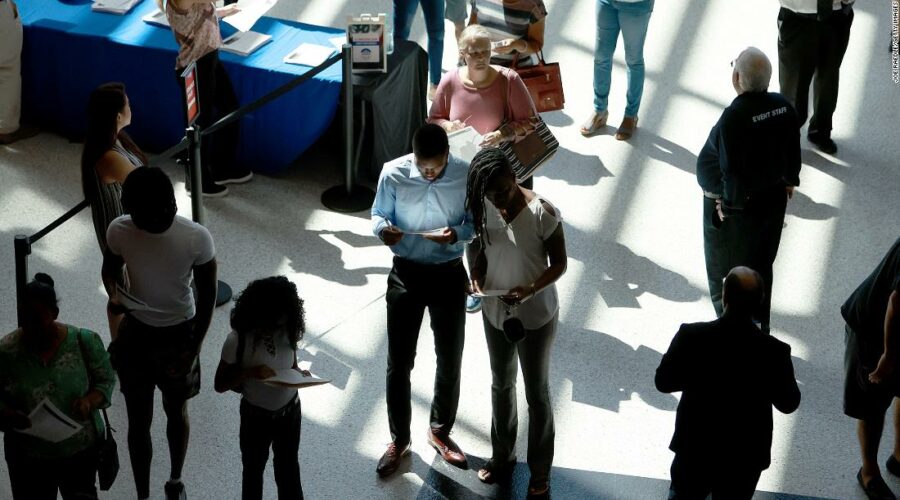NFT collapse, inflation 'pain,' and Serena's next play. Welcome to 'Nightcap'
This story is part of CNN Business’ Nightcap newsletter. To get it in your inbox, sign up for free, here.
New York (CNN Business)Friday morning, economists and investors everywhere will be focused on one document, the US August jobs report, for a read on how the world’s biggest economy is faring.
Fed officials, in particular, will be watching closely, as it is one of the last major economic data releases they’ll have before their mid-September policy meeting.
Here’s what you need to know:
- Even as consumer sentiment and economic growth has slowed this year, the labor market has been on fire, my colleague Alicia Wallace reports.
- Or rather: “The labor market isn’t just running hot, it’s like a burning inferno,” said Megan Greene, global chief economist for the Kroll Institute.
- Forecast: Economists estimate that about 300,000 jobs were added in August. That’s a big slowdown from July, when 528,000 were added, but not the kind of slowdown the Federal Reserve is looking for.
Hold up — the Fed wants less job growth? Seems counterintuitive, but, yeah. The Fed has a dual mandate to ensure maximum employment (which we have) and price stability (which we definitely don’t have). And as Chairman Jay Powell reminded the world so bluntly in Jackson Hole last week, the Fed is going to keep raising interest rates (which makes borrowing more expensive, slowing business activity) until inflation relents.
It’s a long road ahead: Price surges are hovering around a 40-year high of 8.5%. The Fed wants to get that down to 2%.
In effect, the Fed is wagering that the resulting pain of unemployment is less broadly harmful than the pain of inflation.
Key quote: “Without price stability, the economy does not work for anyone.”
Of course, not everyone agrees with the Fed’s strategy. Much of the root cause of inflation — supply chain disruptions, the pandemic, geopolitical tensions — are well out of the central bank’s jurisdiction. Raising interest rates tackles the demand side (consumers will buy less) rather than addressing the supply side.
“What [Powell] calls ‘some pain,’ means putting people out of work, shutting down small businesses because the cost of money goes up,” Senator Elizabeth Warren told CNN’s Dana Bash last weekend.
She’s not wrong. Powell often euphemistically calls it “softening of labor market conditions.” What he means is higher unemployment, which means less consumer spending, which brings prices down.
BOTTOM LINE
The Fed’s trying to trade one kind of pain (inflation) for another kind of pain (unemployment).
But Powell has repeatedly said that the labor market’s strength is evidence the economy can handle higher rates. Of course, that’s little consolation to the people whose jobs end up on the chopping block.
A third three-quarter-point hike isn’t a foregone conclusion. The Fed will have to weigh tomorrow’s jobs numbers along with the results of the consumer price index, due out a week before the central bank’s Sept. 21 meeting, to get a clearer view of the inflation puzzle.
NUMBER OF THE DAY: 155,000
At least 155,000 workers in the United Kingdom are on strike, including rail workers, lawyers, journalists and postal service staff, demanding higher pay as inflation soars to its highest level in decades.
It’s one of the most significant waves of industrial unrest in the UK since the “winter of discontent” in the late 1970s, when rampant inflation pushed workers to stage mass walkouts.
THE EDIT BUTTON
Now for some not-terrible and relatively Musk-free news from Twitter, as a treat.
It only took 800 years of pleading and begging but the Twitter gods have finally granted the world’s request for a freakin’ edit button.
“This is happening and you’ll be okay,” the company tweeted. (Ahem, AP style on that would be “OK,” instead of “okay,” plus it saves two whole characters! See, Twitter, everyone needs an editor.)
This isn’t a huge surprise — Twitter teased at it back in April, on the same day it announced Elon Musk would join its board (lol).
(ICYMI, Musk accepted the board seat, then bailed a few days later. And then he offered to buy Twitter outright. And now he’s in court trying to bail on that. Are you sensing a pattern?)
The lack of an edit button has been an issue for as long as Twitter’s been around. Facebook and Instagram have had it for years. Why, oh why, Twitter, did you make me suffer the public shame of my own misspellings and general carelessness?
Apparently, some people worried about how editing could be weaponized, my colleague Clare Duffy writes. Like, say a harmless tweet goes viral and then gets edited to include harassment or misinformation? (To which I say, if you’ve ever tried to make a tweet go viral, you know how unlikely this scenario is. But I digress…)
To avoid that misinformation potential, Twitter said tweets will be able to be edited “a few times” for up to 30 minutes after they are first posted. Edited tweets will appear with an icon, label and timestamp to make it obvious they have been modified, and users can click through to a tweet’s “edit history” to see past versions.
Good idea. Not to miss out on this trend, starting next week, Nightcap subscribers will get a version of the newsletter in which you can read all my terrible jokes and discarded takes that I cycle through every day to emerge with this still-imperfect-and-not-always-typo-free product. (I’m kidding, of course — I would never subject you to that kind of torturous sausage-making content.)
Enjoying Nightcap? Sign up and you’ll get all of this, plus some other funny stuff we liked on the internet, in your inbox every night. (OK, most nights — we believe in a four-day work week around here.)
Source: Read Full Article

